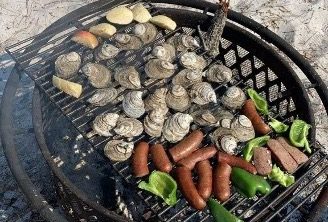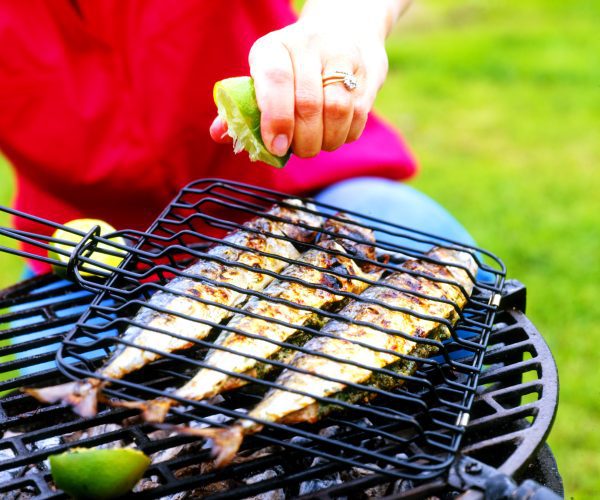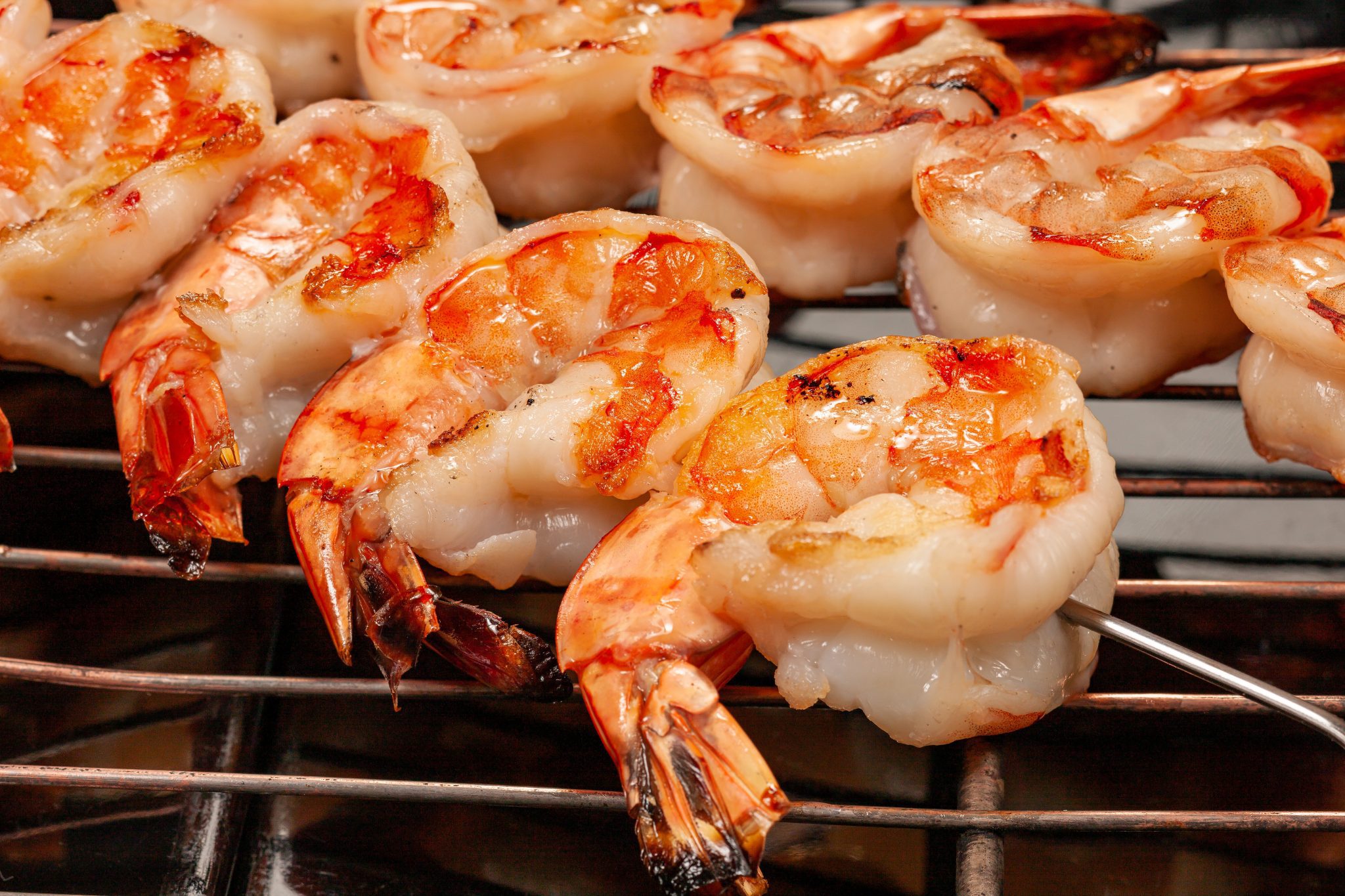Food Safety

Alabama has an abundance of seafood suitable for grilling. Learn techniques for preparing, cooking, and storing Alabama seafood.
On any warm evening from spring through autumn, Alabama families participate in a generations-old tradition: the backyard cookout. Grilling or cooking out goes beyond a simple means of preparing food. The activity can serve as a form of recreation and become the focus for gatherings for families and friends.
In years past, grilling usually meant cooking hot dogs, hamburgers, steak, or chicken over charcoal. Among the equipment now available for outdoor cooking are electric, gas, and pellet grills. An unlimited array of food now seems destined for the backyard grill.
Many kinds of seafood are prime candidates for grilling because of their nutritional composition, physical attributes, and flavor. Most seafood is low in fat, which (aside from being less prone to flare-ups) provides a healthy source of high-quality protein. According to the 2020–2025 Dietary Guidelines for Americans (DGA), eating seafood beginning at around 6 months and continuing through all stages of life can be beneficial to health. The DGA encourage adults and children to eat seafood 2 or 3 times a week for the following benefits:
- Seafood consumed regularly during pregnancy can help brain development in babies.
- Seafood starting at age 6 months provides critical nutrients such as iron, omega-3’s, and choline that support brain development and immunity for infants and toddlers. Lifelong taste preferences and healthful food choices can also be shaped by introducing seafood early.
- For adults, seafood provides protein, calcium, and vitamin D, which help strengthen bones and maintain muscle mass.
Seafood has smaller percentages of skeletal and connective tissues compared to equal portions of red meats or poultry. This makes seafood fast and easy to grill. Seafood also offers a variety of flavors that can be enhanced during the grilling process. For seafood recipes, visit the Eat Alabama Seafood, The Catfish Institute, and Dish on Fish websites.
Grillable Alabama Seafood
Whether you catch them yourself or purchase them from a seafood retailer, many Alabama fish, crustaceans, and mollusks are ideal for outdoor grilling. The following is a basic list of Alabama seafood suitable for the grill. Check with your local seafood retailer to find out what is fresh, seasonal, and suited to your budget.
Fish
- Amberjack
- Bluefish
- Catfish
- Cobia (Ling)
- Croaker
- Flounder
- Grouper
- Mahi-Mahi (dolphinfish)
- Mullet
- Pompano
- Porgy (Sea Bream)
- Rainbow trout
- Redfish (Red Drum)
- Seatrout
- Snapper (numerous species)
- Spanish mackerel
- Striped bass
- Tuna
- Wahoo
Mollusks
- Oysters
- Aquacultured oysters
Crustaceans
- Softshell crabs
- Freshwater prawns
- Shrimp (pink, white, brown, royal red)
Serving Amounts
How much seafood to buy depends on the number of people you are feeding and whether the seafood will be in a sauce or mixed with other ingredients. The following is an estimate of the amount of seafood to buy.
Fish Per Person
For whole fish, consider 3⁄4 to 1 pound (12 to 16 ounces) per person. Dressed fish that is ready to cook, meaning headed, gutted, scaled, and fins removed, will take 6 to 8 ounces. Fillets are practically boneless sections of flesh cut from either side of the backbone. Steaks are crosswise cuts of fish that include a small portion of the backbone. For either fillets or steaks, you need 4 to 6 ounces per person.
 Mollusks (Oysters) Per Person
Mollusks (Oysters) Per Person
- In the shell: oysters, 1⁄2 to 1 dozen depending on size
- Shucked: oysters, 1⁄2 to 1⁄3 pound
Crustaceans Per Person
- Shrimp:
- Whole: 1 dozen
- Headed: unpeeled, 1⁄2 pound
- Headed: peeled, 1⁄3 pound
- Crab:
- Live meat:1 to 11⁄2 pounds
Freshness and Quality Attributes
Fresh seafood should not smell fishy, sour, or ammonia-like. Choose seafood that has a faint sea odor. Freshly cut fish, peeled crustacean meats, and shucked mollusks should be moist, never slimy or dry around the edges.
Fresh, high-quality fish have clear, well-rounded eyes. Older fish may have eyes that are clouded, dry, and sunken in. The gills of fresh fish are bright red or pink, not darkened or slimy. The flesh of fish should be moist and springy to the touch, not mushy.
Crustaceans also have several easily noticed quality- recognition points. The tail meat from prawns and shrimp should be uniformly light-colored with no signs of discoloration around the tail joints. Reject crustacean tail meat that is slimy or smelly. Likewise, fresh soft-shell crabs should have a mild, pleasant odor. The crab’s color should be bright.
Make sure mollusks (oysters) purchased in the shell, are alive. Live molluscs hold their shells closed tightly when handled. If the shells do not close, do not purchase them. In a container, shucked mollusc meat should be plump and covered in its liquor. The liquor should be clear and slightly milky or light gray with no sign of shell pieces or grit. Containers for raw shucked shellfish must bear a legible label that states a “sell by” or “best if used by” or the date shucked for packages holding one-half gallon or more. Check the label before purchase.
Storing Seafood
Fish, crustaceans, and mollusks are among the most perishable muscle protein commodities. Ideally, seafood should be purchased the day it is going to be used.
Of course, that is not always possible. Take care to adequately and appropriately refrigerate or freeze fish and seafood until it is prepared and cooked.
In general, fresh fish should be used quickly within one to two days of purchase. Wash fresh fish in cold water, pat dry with a paper towel, wrap in plastic wrap, and store in an airtight container in the refrigerator at 32° F to 38° F. Check the air temperature of the refrigerator using a refrigerator thermometer. Fish can be frozen in water and stored in a freezer at 0 degrees F or lower for 4 to 6 months.
Refrigerate live shellfish in a well-ventilated container and cover the container with a damp cloth or paper towel to keep them alive until grilling. Live oysters should be used within 2 days. Scrub live shellfish with a stiff vegetable brush just before grilling. If shells open during storage, tap them. If they close, you can grill them. If not, discard them. After cooking, also discard any that do not open. Frozen mollusks are not good candidates for grilling because the meat is soft and prone to shrinkage.
Live crabs move their legs. Crabs will not be active if they have been refrigerated but should move at least a little. Fresh soft-shell crabs will maintain their quality better when sealed in plastic wrap and packed in ice in the refrigerator. For maximum quality, use within 2 days of purchase. Soft-shell crabs can be frozen and good quality maintained for up to 3 months if they are sealed in several layers of plastic wrap, foil, or moisture-proof paper and stored in a freezer at 0 degrees F or lower. Thaw soft-shell crabs overnight in the refrigerator only.
Store fresh shrimp and shucked shellfish in a refrigerator at 32 degrees F to 38 degrees F in a leak-proof plastic bag or airtight container and consume in 2 to 3 days. Fresh shrimp can be frozen with or without the shell. For best quality, freeze raw shrimp that has been washed with heads removed but shells still on. In a storage container or freezer bag, cover shrimp with cold water, seal, and freeze. The recommended freezer shelf life of shrimp is 3 to 6 months.
 Grilling Techniques
Grilling Techniques
- If you are going to cook with charcoal briquettes, line the interior of the barbecue grill with foil for easier cleanup.
- Clean the grill thoroughly.
- Avoid strong lighter fluids or self-lighting briquettes because their odors can overwhelm delicate seafood flavors. Use an electric fire starter or kindling instead.
- A hot fire (375 degrees F to 425 degrees F) is best for cooking seafood. Start briquettes about 30 minutes before you begin cooking. Let the briquettes burn until white-hot, then spread coals in a single layer. Set outdoor gas or electric grills at 425 degrees F and preheat for 15 minutes.
- Oil both the grate and the seafood with vegetable oil or nonstick spray to prevent sticking before placing the grate on the grill.
- Place the grate on the grill and adjust the height 4 to 6 inches above the heat source.
- Cook small, whole, or butterflied fish, fish steaks, fillets, kabobs, crustaceans, and mollusks directly over the heat source.
- Use indirect heat for large whole or stuffed fish. If you are cooking with briquettes, bank hot coals on either side of the barbecue grill and place the fish in the middle of the grill. If you are using an electric or gas outdoor grill, heat the burner on the opposite side.
- For fragile fish, use an oiled, hinged fish basket, a small-mesh seafood grilling screen, or perforated aluminum foil.
- Baste seafood frequently to maintain moistness and prevent sticking.
- Turn most seafoods halfway through cooking time. Fish fillets under 1⁄2-inch thickness do not have to be turned.
Cooking Time Critical
The most important point to remember when cooking seafood is not to overcook it. Perfectly grilled seafood is moist and flavorful. Overcooked seafood becomes dry and tasteless. To estimate cooking time, measure the seafood at its thickest part (including stuffing). Grill 10 minutes (at approximately 400 degrees F) per inch of thickness. Turn the seafood halfway through the cooking time.
Fish is cooked but still moist when it turns opaque or just starts to flake when tested with a fork. To prevent foodborne illness, grill a large whole or stuffed fish with indirect heat 10 to 12 minutes per inch of thickness to reach an internal temperature of 145 degrees F. (Use a calibrated food thermometer to determine doneness in the thickest part.)
Shrimp and soft-shell crab turn opaque (milky white) when done. Mollusks in the shell, such as oysters, clams, and mussels, open when cooked.
Once seafood has reached its safe internal temperature, remove it from the grill and place it on a clean platter. Do not put cooked food on the same platter that held raw seafood. Clean the food thermometer with hot, soapy water.
Keep food at a safe temperature during the entire cookout. Refrigerate leftovers within 2 hours or 1 hour if the air temperature is above 90 degrees F.
Raw Seafood and Foodborne Illness Risk
If you are in a high-risk population group, which includes younger children (age 5 and under), older adults (age 65 and older), pregnant women, and immune-compromised individuals, you are at a higher risk of getting a foodborne illness. In addition, certain health conditions put you at risk for serious illness or death. Individuals with the following conditions are at higher risk:
- Liver disease, either from excessive alcohol intake, viral hepatitis, or other causes
- Hemochromatosis, an iron disorder
- Diabetes
- Stomach problems, including recent stomach surgery and low stomach acid (from antacid use)
- Cancer
- Immune disorders, including HIV infection
- Long-term steroid use (as for asthma and arthritis)
Check with your doctor if you are unsure of your risk. Eating raw or undercooked seafood, especially raw oysters, can put you at risk of infections such as vibriosis. Vibriosis is caused by some types of Vibrio bacteria. An oyster that contains Vibrio does not look, smell, or taste any different from any other oyster. When eating shellfish be sure they are properly and thoroughly cooked to kill harmful bacteria. Shellfish safe to eat will open during cooking. Throw out any shellfish that do not open fully after cooking.
Added Flavor
- Specialty woods, such as oak, hickory, pecan, mesquite, fruit woods, and grapevine cuttings lend a subtle flavor to grilled seafood. Soak wood shavings or chips for 30 minutes before cooking. Place a handful of drained, damp chips on briquettes (or in a separate aluminum or cast iron smoke pan just above the heat source in electric or gas grills) right before cooking.
- Fresh or dried herbs such as thyme, rosemary, dill, basil, marjoram, paprika, and oregano, enhance the flavor of seafood. Soak herbs in water for several minutes, drain, and pat dry. Toss damp herbs directly onto briquettes (or lava rocks) just before cooking.
- Marinades can be as easy as a bottled salad dressing or a homemade combination of oil with vinegar or fresh lemon or lime juice and your choice of seasonings. Save extra, unused marinade to brush on seafood as it cooks.
- Sauces should enhance—not mask—the taste of seafood. Match the flavor level of the sauce to the seafood being grilled. Baste with a mixture of equal parts lemon juice and butter or margarine. Alternately, mayonnaise can be spread on fish fillets to keep them moist.
Other General Pointers
- Be sure fish and crustaceans are completely cleaned (scaled, eviscerated, peeled) before grilling.
- Make sure mollusks are alive. Remove mud from shells by scrubbing with a brush under cold, running water.
- Pat seafood dry with paper towels before applying oil.
- Use square-sided, not round, skewers for seafood kabobs.
 Revised by Alice Moore, Regional Extension Agent, Food Safety and Quality, Auburn University. Originally written by Brian E. Perkins, former Extension Seafood Technologist.
Revised by Alice Moore, Regional Extension Agent, Food Safety and Quality, Auburn University. Originally written by Brian E. Perkins, former Extension Seafood Technologist.
Appreciation is expressed to P. J. Waters and Dani Reams for their review of this material and to Eat Alabama Seafood, National Fisheries Institute, UF/IFAS Extension, Delaware Sea Grant, Clemson Cooperative Extension, CDC, FDA and the Florida Department of Natural Resources, Bureau of Seafood Marketing, for information used. This work is partly a result of research sponsored by NOAA, Office of Sea Grant, Department of Commerce, under Grant No. NA18OAR4170080. MASGP-21-063.
New January 2022, Grilling Alabama Seafood, ANR-0758

